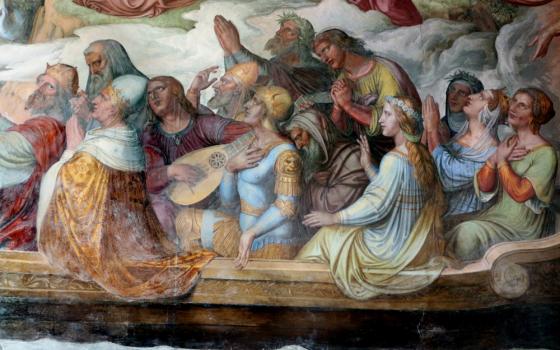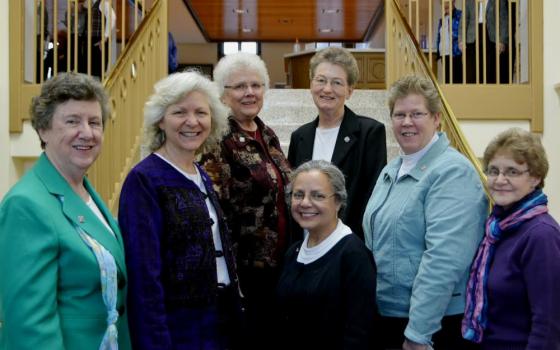"I wish I was not in leadership in a time of diminishment."
I remember making this statement almost 35 years ago when I was part of a newly elected leadership team. Little did I know!
In March 2019, my province of about 900 sisters will be electing a new team whose "mandate" is to continue downsizing four campus properties that have been home to many of us, and to provide planning for corporate ministries, look for health care facilities, work for peace and justice, and hopefully ground us in a lasting legacy of communion with Earth.
It is out of these expectations (also faced by other religious communities) that I look at the role of leadership in a time of creative chaos.
The "holy work" of tedious meetings, internet overload, years of suggestions for options, hundreds or thousands of miles of travel — sleeping in different beds, eating a variety of food — feels like a torture from Dante's Purgatorio!
Who would choose to accept such a congregational "call"? It is a challenge, not unlike Dante's experience as an exile and pilgrim in Paradiso XVII. "You shall learn how salt is the taste of another man's bread and how hard it is to go down and then up another man's stairs.
I asked our current provincial leader, Mary Anne Owens, to comment on my perspective.
"It sounds a bit dire!" she said honestly.
But her clarification gave my assessment some balance.
She suggested that this is the job description of many sisters and laity who are engaged in similar efforts. She said, "The role of the leader is always to thank them, give meaning to the activities, and give hope for a future with our God in whom we have placed our lives and trust."
Mary Anne said that, in these past eight years, her experience has been "that ours was a unique time of creating something new in the midst of recognizing our limited capabilities in personnel and resources, which resulted in a new province."
And she commented on my comparison with Dante as an exile: "As leader, you are not so much an exile as you get to know the sisters. You are enriched by their stories and, for the most part, their attitudes of acceptance and willingness to continue the mission, regardless of the cost, energize me with hope." I am grateful for her perspective.
I wanted to use the lens of Dante's Purgatorio to explore this holy work of leadership in a time of creative chaos, recalling that Dante was a Catholic intellectual who freely pursued truth (an essential for exploring the future together).
Dante recognized his need for guides from science, classic Roman antiquity, Hebrew and Christian Scripture, his church, Jews, Muslims and others — similar to leaders of congregations today.
Dante, the exile and pilgrim, learned the hard reality of being a political exile, a pilgrim whose journey eating unfamiliar food or living in someone else's house left a deep longing for home.
His exile was the result of political factions that were destroying efforts to build true community within families, cities, church or nation. For this reason, he chose to place "heretics" in the sixth circle of the Inferno, not for teaching incorrect doctrine, but for creating an "I'm right, you're wrong" attitude that continued to destroy any possibility of communal harmony and that stifled dialogue.
The primary source for his poem was creation, which led him to travel into a universe of amazing depth and beauty, looking at Earth from space and seeing "the fair planet that emboldens love, smiling, lit up the east, veiling the Fishes in her train."
It is not enough to read only the Inferno. Dorothy Sayers is quoted as saying, "To know Dante and the Commedia only through Inferno is like knowing the city of Paris only through its sewer system."
Though I am not a Dante scholar, I am indebted to this 14th-century poet and pilgrim whose insight continues to guide me. In his Purgatorio, Dante the pilgrim observed how others remained faithful even as they struggled to climb one more critical circle of self-knowledge, hoping to grow in compassion. He learned that God's mercy is beyond imagining.
That book reminds us that Dante, with Virgil as guide, climbs into the timeless silence and beauty of fresh air, moved at seeing the stars, hearing music for the first time since beginning their journey through the dark, violent, evil-smelling Inferno.
Dante sees those who have accepted responsibility for their actions, moving toward deeper repentance, making the Purgatorio a place of hope, so different from the despair and isolation of the Inferno. Here they meet people who speak courteously to one another, knowing their struggle will lead to eternal communion in the Paradiso.
He recognizes that each terrace is related to a capital sin; artwork depicting the redeeming virtue is presented for imitation. For example, on the terrace of pride, he sees lifelike depictions of Mary's humility at the Annunciation, which is underscored by the beatitude, "Blessed are the poor in Spirit for the kingdom of heaven is theirs."
In making the Beatitudes and Sermon on the Mount the goal for all persons of goodwill, regardless of religious affiliation, Dante seems to anticipate our present age. He recognized that it was the hard work of personal commitment to active citizenship and human decency that enabled community to happen and good leaders to emerge.
Like him, some religious congregational leaders recognize a paradigm shift moving us into an evolutionary consciousness. Their starting point is often a universe that has been revealed to us through science, technology and the mystics of all traditions.
Dante recognizes his own need for conversion as he passes those whose pride had been crushed by self-knowledge, whose envy had been turned into sharing center stage, whose sense of "doing it my way" had moved into engaging with opposition and finding common ground.
Visiting Dante's 14th-century Florence to consider the holy work of leadership in a time of creative chaos reminds me of our international religious community leaders who led us during World War II, communism and then into the challenges of international dialogue.
I am inspired by Mother Almeda Schricker who led our congregation during World War II. In our Munich-based generalate, she and her council made the difficult decision not to cooperate with Hitler. This meant — among other things — a loss of 700 paid positions for the School Sisters of Notre Dame in Nazi Germany.
A Berlin superior showed me her false-bottomed purse during my visit in 1970. The night before she was to make her trip through the Berlin Wall to visit almost 200 sisters living in communist East Berlin, she would place the purse near the statue of St. Joseph. The next day, she would follow her intuition regarding whether it was safe to take dangerous documents or not.
Several of our sisters risked imprisonment by sewing copies of our new constitution in the hem of their habits and walking them past guards into communist Eastern Europe.
I met a sister in Berlin, a refugee from Poland, who shared her story with me. "I was from another religious community. But with the chaos of fleeing our convent, I lost my community and the School Sisters took me in."
Leadership in a time of chaos has shown me the face of fidelity. I am learning to trust a bigger plan of which we are a part: It may be one step moving toward strengthening Earth community, moving away from factionalism, and doing the "great work" of raising evolutionary consciousness.
Leaders of women religious rely on the well of living water — an aquifer of contemplative energy. It is holy work, and I am grateful to those who say yes to leadership in a time of creative chaos.
As Dante said in Canto III , "In your will, oh God, is my peace"
[Judith Best is a School Sister of Notre Dame and coordinator of SturdyRoots.org. She gives presentations on the heritage of the School Sisters of Notre Dame and is also exploring evolution as the bridge between science and religion.]


